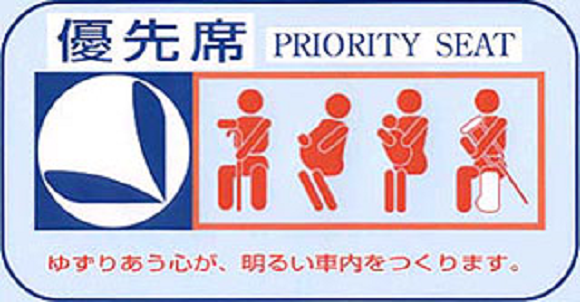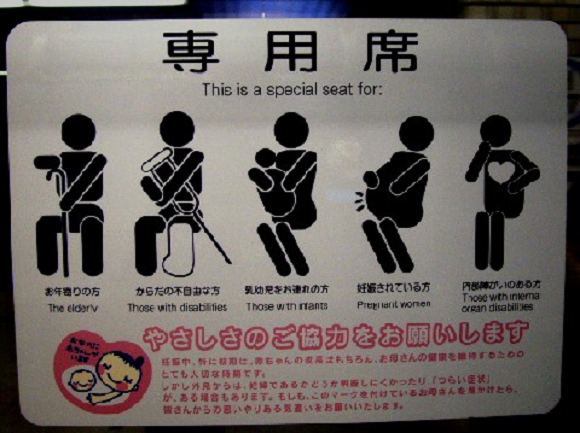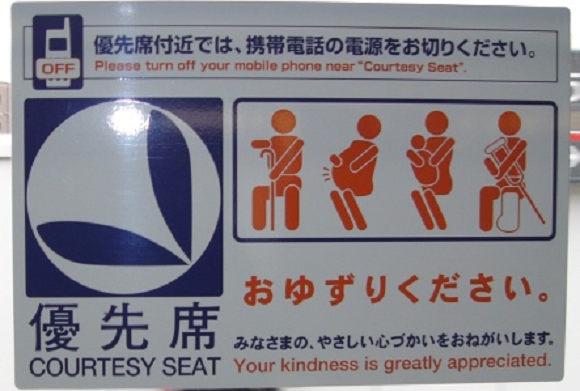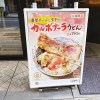With how crowded trains get during rush hour in Japan, finding an open seat can be like discovering an oasis in the desert, or a cold can of Ebisu beer in the fridge nestled behind a group of lesser brews. Oftentimes, though, you’ll step into the train and find every seat occupied.
While no one really likes standing for a 30- or 60-minute ride, for some elderly, pregnant, infant-accompanying, or handicapped passengers, that’s not just an unpleasant situation, but a painful, or even impossible, task. Those groups of people still have as much need for mobility as anyone else, though, so rail companies put up signs directing those passengers to special seats for them along the corner benches of each car.
It seems that able-bodied passengers in different parts of Japan react differently to these suggestions, though. Not only that, not everyone believes keeping those seats open is the right thing to do, and a lot of it has to deal with a subtle difference in the wording used in Tokyo and Sapporo.
Setting off the debate was a photo, shared by artist and Twitter user Robot Nozomi. Snapped while on the train in Sapporo, the largest city on Japan’s northernmost island of Hokkaido, it shows passengers crammed into every available patch of space inside the carriage, except one.
https://twitter.com/ROBOT_NOZOMI/status/498610577799802880
Along with the photo, Nozomi tweeted:
“In Tokyo, a lot of regular people sit in the priority seats, but in Sapporo, none of them do, even if the train is packed. Now I get it. This is how it’s supposed to be.”
As you’d expect from the show of conscientious kindness, many who saw the snapshot were impressed. “That’s wonderful,” earnestly commented one person, and a few of the locals were filled with a sense of pride. “That’s just how we do things here!” replied one Sapporo resident.
Still, not everyone was sold on the Sapporo-style seating standards. “I think that’s really kind and all, but even if I was injured or handicapped, that sort of atmosphere would make it hard for me to take a seat,” explained one self-conscious individual.
Others just didn’t see the upside of leaving seats empty if there was no one around who needed them. “That’s actually a nuisance for the other people on the train,” grumbled another detractor.
For some, there’s even a safety issue involved. “It can be dangerous to have too many people trying to occupy the same space,” he explained, asserting that spreading passengers out, in this case by having some sit in the special seats, would help people from crashing into one another in the case of an accident, sudden stop, or just as a result of the regular swaying of the train. This can turn into a bone-cracking human domino-tipping session surprisingly quickly.
Actually, there might be something more at play here than just the hustle and bustle of 13 million-person Tokyo versus the laid-back kindness of the smaller Sapporo and its two million residents. A lot of this could be chalked up to a difference in how those seats are labeled in the two cities.
If we take a look at the Japanese word Nozomi used in his tweet, he refers to the special seats as yuusenseki, literally “priority seats.”
▼ 優先席 / yuusenseki
That’s also what you’ll see written inside train and subway carriages in Tokyo, and most people interpret the term to mean that senior citizens, pregnant women, and the disabled should be given the seats ahead of any other passengers. Alternatively, if there’s no one around who fits into those groups, the priority seats are fair game, at least for the time being.
On the other hand, the trains in Sapporo apparently don’t call them yuusenseki. Instead, they’re senyouseki, the kanji characters for which mean “exclusive use seats.”
▼ 専用席 / senyouseki
There don’t seem to be any rules expressly prohibiting others from sitting in them, or levying fines against those who do. It’s even possible that whoever chose the name wasn’t even thinking about the stricter connotation it entails. Nevertheless, it looks like passengers in Sapporo take the designation seriously enough that if no one on the train belongs to one of the groups the senyouseki have been set aside for, then they should be left empty.
So who’s got the linguistic high ground? Well according to some people, it doesn’t really matter. In regards to Sapporo’s custom, one commenter felt, “This way of thinking, in and of itself, is admirable, but there’s no need to systematize it. It’s good manners to give your seat up for someone who needs it, and natural to sit down if no one does.”
Another open-minded individual concurred. “Whether you call them ‘priority’ or ‘exclusive use,’ what’s important is to think of the needs of the people around you.”
And as for what to call these seats in English? Well, it may be a little on the vague side, but we think this alternate translation for yuusenseki, used by the Tokyu rail network which runs through southwest Tokyo and Kanagawa Prefecture, perfectly encapsulates the spirit behind them.
Source: Jin, Twitter
Insert images: University of Tsukuba, Geocities, Nifty Cocolog




 Should healthy young men sit in Japanese trains’ priority seats for the elderly and pregnant?
Should healthy young men sit in Japanese trains’ priority seats for the elderly and pregnant? Video of foreign diplomat riding in Tokyo subway priority seat sparks manners debate【Video】
Video of foreign diplomat riding in Tokyo subway priority seat sparks manners debate【Video】 Japanese railway sets up literal love seats with special seating for couples
Japanese railway sets up literal love seats with special seating for couples Nozomi Shinkansen bullet train abolishes low-priced unreserved tickets during peak travel seasons
Nozomi Shinkansen bullet train abolishes low-priced unreserved tickets during peak travel seasons Train etiquette poster features legendary Japanese folklore hero in an unusual plot twist
Train etiquette poster features legendary Japanese folklore hero in an unusual plot twist Red light district sushi restaurant in Tokyo shows us just how wrong we were about it
Red light district sushi restaurant in Tokyo shows us just how wrong we were about it Historical figures get manga makeovers from artists of Spy x Family, My Hero Academia and more
Historical figures get manga makeovers from artists of Spy x Family, My Hero Academia and more Sandwiches fit for a sumo served up in Osaka【Taste Test】
Sandwiches fit for a sumo served up in Osaka【Taste Test】 McDonald’s new Happy Meals offer up cute and practical Sanrio lifestyle goods
McDonald’s new Happy Meals offer up cute and practical Sanrio lifestyle goods Japanese ramen restaurants under pressure from new yen banknotes
Japanese ramen restaurants under pressure from new yen banknotes Limited-edition Carbonara Udon will anger noodle purists and pasta lovers 【Taste test】
Limited-edition Carbonara Udon will anger noodle purists and pasta lovers 【Taste test】 Pokémon Sleep camping suite and guestrooms coming to Tokyo Hyatt along with giant Snorlax burgers
Pokémon Sleep camping suite and guestrooms coming to Tokyo Hyatt along with giant Snorlax burgers Akihabara pop-up shop sells goods made by Japanese prison inmates
Akihabara pop-up shop sells goods made by Japanese prison inmates Tokyo Tsukiji fish market site to be redeveloped with 50,000-seat stadium, hotel, shopping center
Tokyo Tsukiji fish market site to be redeveloped with 50,000-seat stadium, hotel, shopping center Beautiful Sailor Moon manhole cover coasters being given out for free by Tokyo tourist center
Beautiful Sailor Moon manhole cover coasters being given out for free by Tokyo tourist center All-you-can-drink Starbucks and amazing views part of Tokyo’s new 170 meter-high sky lounge
All-you-can-drink Starbucks and amazing views part of Tokyo’s new 170 meter-high sky lounge More foreign tourists than ever before in history visited Japan last month
More foreign tourists than ever before in history visited Japan last month French Fries Bread in Tokyo’s Shibuya becomes a hit on social media
French Fries Bread in Tokyo’s Shibuya becomes a hit on social media Studio Ghibli releases new action figures featuring Nausicaä of the Valley of the Wind characters
Studio Ghibli releases new action figures featuring Nausicaä of the Valley of the Wind characters New private rooms on Tokaido Shinkansen change the way we travel from Tokyo to Kyoto
New private rooms on Tokaido Shinkansen change the way we travel from Tokyo to Kyoto Starbucks reopens at Shibuya Scramble Crossing with new look and design concept
Starbucks reopens at Shibuya Scramble Crossing with new look and design concept Studio Ghibli glasses cases let anime characters keep an eye on your spectacles
Studio Ghibli glasses cases let anime characters keep an eye on your spectacles Beautiful Ghibli sealing wax kits let you create accessories and elegant letter decorations【Pics】
Beautiful Ghibli sealing wax kits let you create accessories and elegant letter decorations【Pics】 Studio Ghibli releases Kiki’s Delivery Service chocolate cake pouches in Japan
Studio Ghibli releases Kiki’s Delivery Service chocolate cake pouches in Japan New definition of “Japanese whiskey” goes into effect to prevent fakes from fooling overseas buyers
New definition of “Japanese whiskey” goes into effect to prevent fakes from fooling overseas buyers Our Japanese reporter visits Costco in the U.S., finds super American and very Japanese things
Our Japanese reporter visits Costco in the U.S., finds super American and very Japanese things Studio Ghibli unveils Mother’s Day gift set that captures the love in My Neighbour Totoro
Studio Ghibli unveils Mother’s Day gift set that captures the love in My Neighbour Totoro New Japanese KitKat flavour stars Sanrio characters, including Hello Kitty
New Japanese KitKat flavour stars Sanrio characters, including Hello Kitty New Pokémon cakes let you eat your way through Pikachu and all the Eevee evolutions
New Pokémon cakes let you eat your way through Pikachu and all the Eevee evolutions Disney princesses get official manga makeovers for Manga Princess Cafe opening in Tokyo
Disney princesses get official manga makeovers for Manga Princess Cafe opening in Tokyo Sales of Japan’s most convenient train ticket/shopping payment cards suspended indefinitely
Sales of Japan’s most convenient train ticket/shopping payment cards suspended indefinitely Sold-out Studio Ghibli desktop humidifiers are back so Totoro can help you through the dry season
Sold-out Studio Ghibli desktop humidifiers are back so Totoro can help you through the dry season Japanese government to make first change to romanization spelling rules since the 1950s
Japanese government to make first change to romanization spelling rules since the 1950s Ghibli founders Toshio Suzuki and Hayao Miyazaki contribute to Japanese whisky Totoro label design
Ghibli founders Toshio Suzuki and Hayao Miyazaki contribute to Japanese whisky Totoro label design Doraemon found buried at sea as scene from 1993 anime becomes real life【Photos】
Doraemon found buried at sea as scene from 1993 anime becomes real life【Photos】 Tokyo’s most famous Starbucks is closed
Tokyo’s most famous Starbucks is closed One Piece characters’ nationalities revealed, but fans have mixed opinions
One Piece characters’ nationalities revealed, but fans have mixed opinions We asked a Uniqlo employee what four things we should buy and their suggestions didn’t disappoint
We asked a Uniqlo employee what four things we should buy and their suggestions didn’t disappoint Princesses, fruits, and blacksmiths: Study reveals the 30 most unusual family names in Japan
Princesses, fruits, and blacksmiths: Study reveals the 30 most unusual family names in Japan Japan Rail now accepting suggestions for how to use a car on the Nozomi bullet train in March 2022
Japan Rail now accepting suggestions for how to use a car on the Nozomi bullet train in March 2022 All aboard Tokyo’s Love Train!
All aboard Tokyo’s Love Train! Japanese senior stabs younger man multiple times after seeing him sit in train’s priority seat
Japanese senior stabs younger man multiple times after seeing him sit in train’s priority seat Chinese guy discovers way to get a seat on a busy train – fake seizures【Video】
Chinese guy discovers way to get a seat on a busy train – fake seizures【Video】 Bold as brass: Trombonists take over last-train, earn Twitter fans and critics【Video】
Bold as brass: Trombonists take over last-train, earn Twitter fans and critics【Video】 Why do seats at some Japanese station platforms face away from the trains?
Why do seats at some Japanese station platforms face away from the trains? Japan’s high-speed Shinkansen train makes emergency stop as snake is found onboard
Japan’s high-speed Shinkansen train makes emergency stop as snake is found onboard Inconsiderate commuter behavior in Korea – A photo guide
Inconsiderate commuter behavior in Korea – A photo guide Beautiful Japanese sightseeing train will be unforgettable way to travel country’s north island
Beautiful Japanese sightseeing train will be unforgettable way to travel country’s north island Nigh-unsittable seats spotted in Tokyo, leaves us scratching our heads in confusion
Nigh-unsittable seats spotted in Tokyo, leaves us scratching our heads in confusion Is the new Shinkansen Train Desk ticket worth it?
Is the new Shinkansen Train Desk ticket worth it? Is it OK to play with Pokémon card on the Shinkansen? A bullet train manners debate
Is it OK to play with Pokémon card on the Shinkansen? A bullet train manners debate Osaka earthquake hits city during peak hour, passengers freed after trains suspended
Osaka earthquake hits city during peak hour, passengers freed after trains suspended Shinkansen travel tip: A clever way to keep your suitcase from rolling around on the bullet train
Shinkansen travel tip: A clever way to keep your suitcase from rolling around on the bullet train Japanese woman stumbles on the power of the infamous “gaijin seat” phenomenon during flight
Japanese woman stumbles on the power of the infamous “gaijin seat” phenomenon during flight Schoolboy offers elderly man seat on train, gets publicly berated for doing just that
Schoolboy offers elderly man seat on train, gets publicly berated for doing just that
Leave a Reply